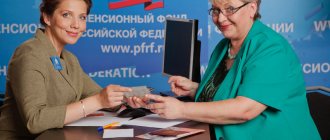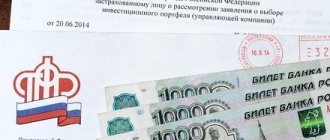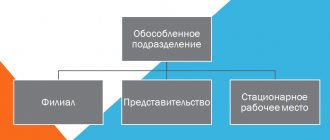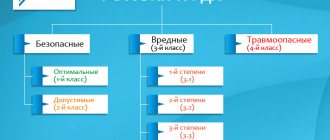Who pays in 2021
In 2021, organizations and individual entrepreneurs must pay insurance premiums at additional rates for compulsory pension insurance. However, not everyone needs to pay additional fees. Additional contributions are accrued only for payments to employees employed:
- in underground work, in work with hazardous working conditions and in hot shops (subclause 1, part 1, article 30 of the Federal Law of December 28, 2013 No. 400-FZ; List No. 1, approved by Resolution of the Cabinet of Ministers of the USSR of January 26, 1991 No. 10);
- on special types of work listed in subparagraphs 2–18 of part 1 of Article 30 of the Federal Law of December 28, 2013 No. 400-FZ (when the old-age insurance pension is due earlier than the general period).
Features of filling out the Calculation using the RSV-1 Pension Fund form
The calculation according to the PFR form RSV-1 for accrued and paid insurance contributions for compulsory pension insurance in the Pension Fund and for compulsory medical insurance in the FFOMS and the procedure for filling it out (hereinafter referred to as the Procedure for filling out RSV-1) were approved by Resolution of the PFR Board dated January 16, 2014 N 2p.
In the PFR form RSV-1, Section 2 includes subsection 2.4 “Calculation of insurance premiums at an additional rate for certain categories of insurance premium payers specified in part 2.1 of Art. 58.3 of Law N 212-FZ” (hereinafter referred to as Subsection 2.4), which since 2014 has been filled out by insurers applying additional tariffs established based on the results of a special assessment of working conditions or certification of workplaces for working conditions (Part 2.1 of Article 58.3 of Law N 212- Federal Law, clause 7, article 7, part 4, article 8, part 4, article 27 of Law N 426-FZ, part 5, article 15 of Law N 421-FZ, clause 14 of the Procedure for filling out the RSV-1).
Thus, paragraph 14 of the Procedure for filling out the RSV-1 of the Pension Fund of the Russian Federation establishes that Subsection 2.4 is filled out by payers of insurance premiums applying additional tariffs in accordance with part 2.1 of Art. 58.3 of Law N 212-FZ in relation to payments and other remuneration in favor of individuals employed in the relevant types of work specified in paragraphs. 1-18 parts 1 tbsp. 30 of Law N 400-FZ.
In general, information in Subsection 2.4 is entered depending on the class of working conditions identified based on the results of a special assessment of working conditions carried out in the manner established by the legislation of the Russian Federation or certification of workplaces for working conditions, taking into account the provisions of paragraph 5 of Art. 15 of Law No. 421-FZ.
According to clause 14.1 of the Procedure for filling out RSV-1, when filling out Subsection 2.4, you must indicate in the “Base code” field “1” or “2”, respectively:
- 1 - if the subsection is completed in relation to payments in favor of individuals who are engaged in the types of work specified in paragraphs. 1 clause 1 art. 27 of Law No. 173-FZ (List 1) (from January 1, 2015 - in paragraph 1 of Part 1 of Article 30 of Law No. 400-FZ);
- 2 - if the subsection is completed in relation to payments in favor of individuals who are engaged in the types of work listed in paragraphs. 2-18 paragraph 1 art. 27 of Law No. 173-FZ (List 2) (from January 1, 2015 - in clauses 2-18, part 1, article 30 of Law No. 400-FZ).
That is, in the case under consideration, in the “Base Code” field of Subsection 2.4 of the RSV-1 Pension Fund, you must indicate “2”.
In the indicator “Section 2.4 is completed on the basis of:” in one of the three fields provided, you must enter the symbol “X”:
— the field “results of special assessment” is filled in by the payer if there are results of a special assessment of working conditions;
- field “results of certification of workplaces” - if there are results of certification of workplaces for working conditions, taking into account the provisions of clause 5 of Art. 15 Law No. 421-FZ;
- field “results of special assessment and results of certification of workplaces” - if there are results of a special assessment of working conditions and results of certification of workplaces for working conditions (taking into account the provisions of paragraph 5 of Article 15 of Law No. 421-FZ).
In the case under consideration, it is necessary to enter the symbol “X” in the field “results of special assessment and results of workplace certification.”
According to clause 15 of the Procedure for filling out the RSV-1, for each class and subclass of working conditions, payments and other remunerations specified in parts 1, 2 of Art. 7 of Law N 212-FZ, cumulatively from the beginning of the year and for each of the last three months of the reporting period:
— for the class of working conditions “Harmful”, subclass of working conditions 3.2, the data is reflected in line 258;
- for the class of working conditions “Harmful”, subclass of working conditions 3.1 - in line 264.
According to clause 15.7 of the Procedure for filling out the DAM-1, for each class and subclass, the number of individuals for whom insurance premiums have been calculated at the additional rate is reflected. In the situation under consideration, the specified information must be reflected on lines 263 and 269, respectively.
In addition, the amount of payments and remunerations accrued in favor of an employee engaged in harmful and dangerous work is reflected in section 6, in subsection 6.7 of the RSV-1 Pension Fund (clause 36 of the Procedure for filling out the RSV-1).
Payments are reflected with the indication in column 3 of the codes for the special assessment of working conditions, which are contained in the Classifier of parameters used when filling out personalized information (Appendix 2 to the Procedure for filling out the RSV-1):
for the class of working conditions “Harmful” and subclass of working conditions 3.2, B3.2 is indicated. For the class of working conditions “Harmful”, subclass of working conditions 3.1 - B3.1.
When specifying several codes, the number of lines in subsection 6.7 of the RSV-1 Pension Fund increases accordingly.
Column 5 must reflect all payments that are accrued in favor of an employee engaged in the types of work specified in paragraphs. 2-18 paragraph 1 art. 27 of Law No. 173-FZ (List 2) (from January 1, 2015 - in clauses 2-18, part 1, article 30 of Law No. 400-FZ).
The role of special assessment of working conditions
Let us remind you that starting from 2021, the results of workplace certification, which were carried out before 2014, are no longer valid. Contributions for additional tariffs are calculated taking into account a special assessment of working conditions.
If you have not carried out a special assessment, apply additional tariffs for insurance premiums, which are established by paragraphs 1 and 2 of Article 428 of the Tax Code of the Russian Federation.
And if you conducted a special assessment of working conditions and, based on its results, established certain classes or subclasses of working conditions, then apply a differentiated scale of additional tariffs for compulsory health insurance contributions from paragraph 3 of Article 428 of the Tax Code of the Russian Federation.
Procedure and deadlines for paying contributions
Additional leave for hazardous working conditions
For dangerous work, money is paid in the following sequence:
- The time period covered is the end of each calendar month. Calculation is carried out according to tariffs, excluding amounts paid from the beginning of the billing period until the end of the previous calendar month.
- The amount of amounts paid must be calculated in rubles and kopecks.
- The payer is required to keep records of payments.
And now some information about the timing:
- The accrued amount must be paid no later than the 15th day after the end of the billing month.
- If the deadline falls on a weekend or holiday, the deadline is shifted to the first working day following them.
- It is worth mentioning separately the annual deadlines for individual entrepreneurs. It is legally regulated that the last payment for the current year must be made no later than December 31. In practice, these deadlines can be pushed back a little. So, the last payment date for 2021 was 01/09/2019.
Additional tariffs 2021 (special assessment was not carried out): table
The general procedure for using additional tariffs is specified in Article 428 of the Tax Code of the Russian Federation. They are used for certain categories of workers, as well as those employed in certain jobs or depending on the age of the workers and length of service. But only on the condition that the employer did not carry out SOUT.
| TYPES OF JOBS | TARIFF OF CONTRIBUTIONS FOR OPS |
| Underground, with hazardous working conditions and in hot shops | 9% |
| With difficult working conditions | 6% |
| As tractor drivers in agriculture and other sectors of the economy, as well as drivers of construction, road and loading and unloading machines (for women) | |
| With increased intensity and severity in the textile industry (for women) | |
| In expeditions, parties, detachments, on sites and in teams during field geological exploration, search, topographic and geodetic, geophysical, hydrographic, hydrological, forest management and survey work | |
| As working locomotive crews and workers of certain categories, organizing transportation and ensuring traffic safety on railway transport and in the subway, as well as as truck drivers in the technological process in mines, open-pit mines, mines or ore quarries for the removal of coal, shale , ores, rocks | |
| Provided clauses 7-18 hours 1 tbsp. 30 Federal Law dated December 28, 2013 No. 400-FZ |
How to get them back
If there are compelling reasons why a person does not want to keep funds in a certain non-state fund, then he has the right to withdraw them, losing interest.
Unreliability or finding a better offer can be used as an argument. To return, you must write an application and submit it to the current Pension Fund; the form indicates the details for transferring funds. The application is accompanied by documents reflecting the rights to the money and its management.
According to federal law, people who work in dangerous and difficult conditions receive a pension supplement. However, additional contributions are transferred to the funded part of the future payment. The transfer of DSV gives the right to early retirement. State and private programs for increasing funded pensions can bring good dividends; therefore, if the employer makes special contributions for difficult working conditions, then it is worth thinking about increasing the funded part of the pension.
Read also: Law on internship in 2021
Additional tariffs 2021 (special assessment was carried out): table
If the employer has carried out special labor and safety work on the above-mentioned jobs, then, depending on the established class (subclass) of working conditions, the following additional insurance premium rates are applied:
| Working conditions | Assessment of working conditions | Tariff for compulsory pension insurance |
| Dangerous | 4 | 8% |
| Harmful | 3,4 | 7% |
| 3,3 | 6% | |
| 3,2 | 4% | |
| 3,1 | 2% | |
| Acceptable | 2 | 0% |
| Optimal | 1 | 0% |
Read also
21.02.2020
Terms for calculating additional insurance premiums
According to Part 1 of Article 9 of Federal Law No. 56-FZ, additional contributions, regardless of who pays them, are transferred to the Pension Fund within the same time frame as contributions to pension insurance, i.e. for each month until the 15th of the following month. Contributions from employees and employers are transferred to different BCCs (budget classification code)
Each time DSV is accrued to the Pension Fund of the Russian Federation, the employer is obliged to create a register of insured persons to whose account the contributions were transferred. The registration of the register is carried out every month according to DSV-3 (the new form came into force on September 10, 2016).
The register must indicate:
- information about the policyholder - registration number in the Pension Fund of Russia, checkpoint, tax identification number, name of the organization;
- date, number of the payment order on the basis of which contributions are transferred, execution date;
- contribution period;
- information about the employee - full name, SNILS;
- the amount of accrued additional contributions.
The deadline for submitting DSV-3 is set no later than the 20th day of the month following the quarter in which the DSV was translated. For example, if an employer paid contributions for March, April and May 2021, then he must send three DSV-3 registers to the territorial department of the Pension Fund no later than June 20, 2021.
It is worth considering that for those employees who work in conditions of high danger and harmfulness, when determining the right to early retirement, periods of work taken into account to determine preferential length of service are counted only if during this period additional insurance contributions were transferred in their favor.
The procedure for calculating and accruing surcharges for hazardous working conditions
- The first is assigned to a work environment when a person experiences functional changes that require a longer recovery period than the time between shifts. There is a possibility of permanent deterioration in health.
- The second is that the influence of an unfavorable environment leads to persistent functional changes in the body, which are often diagnosed as an occupational disease. Moreover, it is precisely those organs that are affected that are most exposed when performing work in a given specialty without loss of professional ability to work.
- The third is characterized by the presence of factors that provoke the occurrence of diseases in workers that are characteristic of this profession. The body suffers mild to moderate harm, leading to a ban on work in this specialty.
- The fourth degree is characterized by a very negative work environment, leading to severe functional changes in the body and serious occupational diseases with loss of general ability to work.
Concern for the health of the working class was one of the main directions in the USSR. Back in 1974, a list of industries, professions and workshops with particularly difficult working conditions was officially approved. In addition to the list, instructions were developed regulating the procedure for its use. Since that time, specialists whose work was associated with an unfavorable workplace environment have been awarded additional payments.
Practical application of SOUT for Social Insurance Fund
That is, at the moment, there is no effectiveness, as I understand it. because 40% is the same as in the automated workplace, change the working conditions and you will get a discount. So the question is that the employer does not pay an additional tariff to the Social Insurance Fund at all, and then it makes sense for him to carry out SOUT. while GIT does not touch him))
entails a warning or the imposition of an administrative fine on officials in the amount of five thousand to ten thousand rubles; for persons carrying out entrepreneurial activities without forming a legal entity - from five thousand to ten thousand rubles; for legal entities - from sixty thousand to eighty thousand rubles.









